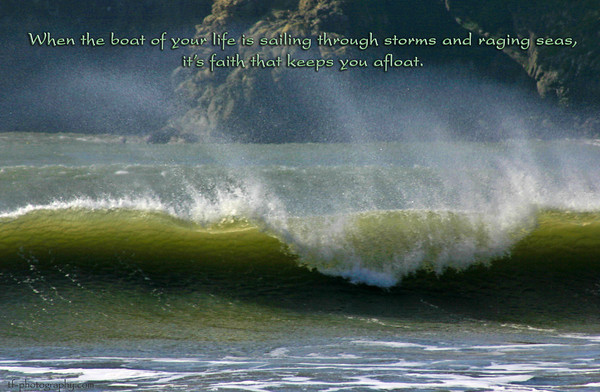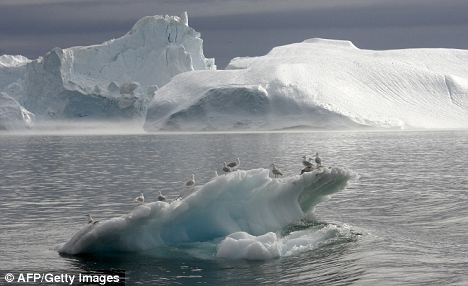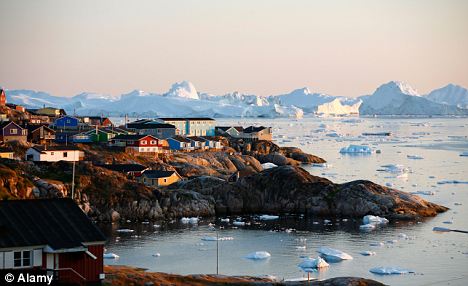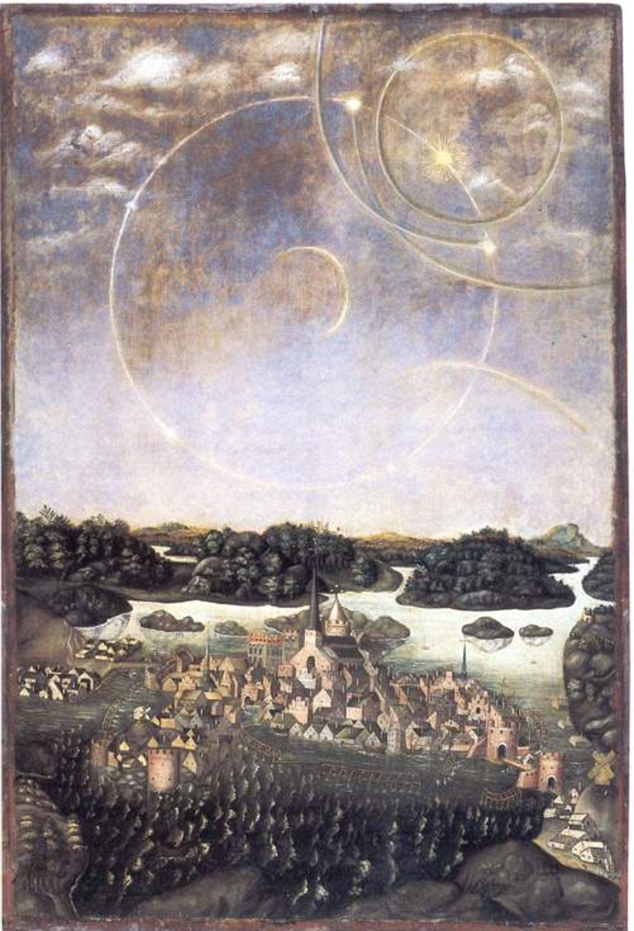The heavens declare the glory of God; and the firmament sheweth his handywork. Day unto day uttereth speech, and night unto night sheweth knowledge. There is no speech nor language, where their voice is not heard. Their line is gone out through all the earth, and their words to the end of the world. In them hath he set a tabernacle for the sun, Which is as a bridegroom coming out of his chamber, and rejoiceth as a strong man to run a race. His going forth is from the end of the heaven, and his circuit unto the ends of it: and there is nothing hid from the heat thereof. (Psalms 19:1-6)
Glory Of God
***
A Life-or-Death Question to Start Your Day
Peter Bregman, HBR, January 11, 2011 -
My wife Eleanor and I were alone on a three-week kayak expedition in Prince William Sound in Alaska. Eleanor was in college; I had just graduated. We had spent plenty of time in the wilderness but never just the two of us, and never this kind of wilderness. When we landed in Anchorage, I looked around for a currency exchange desk before Eleanor reminded me we were still in the U.S.
Prior to arriving, we prepared meticulously, studying the nautical charts, plotting our route, and practicing our kayaking skills. We paddled into the nastiest surf we could find and then rolled ourselves upside down to see how quickly we could either roll back over or get back in the kayak if we came out. In Prince William Sound, there's no margin for error. You can survive in the freezing water only four to five minutes.
Now that we were on Prince William Sound, we were thankful for all the preparations we had done. And knowing how quickly the weather changes in Alaska, we had a ritual of precautions we took every morning before pushing the boat off the relative safety of the beach. We carefully packed everything in waterproof bags and placed those bags in the watertight compartments in our boat. We kept all our essentials--VHF radio, sun block, signal mirror, peanut butter, and chocolate chips: the stuff we couldn't live without--in a dry bag in my kayak cockpit.
And every morning, before we left shore, we asked the same question: If we died today, what mistake would Sea Kayaker magazine get us for?
Before coming to Alaska, I read through the accident reports in every past issue of Sea Kayaker magazine I could get my hands on. The reports identified the mistakes and poor decisions people made that led, more often than I shared with my parents, to their deaths.
One person knew he shouldn't paddle that day because the weather was bad and the surf was rough, but he had a meeting to get to and didn't want to miss the ferry home. Well, he missed that ferry and every one since. Another kayaker, on the last day of his trip, didn't bother to pack his gear in waterproof bags since he didn't expect to need it. But then a wave hit his boat, and he flipped, and everything got wet. He got back to shore but had nothing to keep him warm, and, eventually, died of hypothermia. Then there was the Outward Bound course that found itself surprised by strong winds and currents off the coast of Baja. Three of the students died.
So each morning, before pushing our kayaks away from shore, I stood there for a few minutes thinking about the day--our plan, the weather, our gear, pull-out points, our skills, challenges we might encounter--and then I asked the question: If we died today, what mistake would Sea Kayaker magazine get us for?
And now, years later, from the safety of my office chair, I still think that's the right mentality with which to approach each day. The questions are slightly different. The risks are very different. But the idea is the same: are you prepared for this day? For the meetings you have planned? Have you really thought about the work you plan to do? Anticipated the risks that might take you off track? Are you focused on the larger goals you want to achieve? Will your plan for this day bring you one day closer to achieving them? And, finally, if something goes terribly wrong, what mistake would you get yourself for at the end of the day?
In Alaska, we completed our trip successfully because we took the time to prepare for each day as if that day was the most important day of our lives. Because, in fact, the risks were great enough that if we had not prepared that way, it might have been the most important day of our lives--the last one.

Why not treat today, given that it's the only day you've got right now, with the same importance?
***
Daily Mail
The sun rises two days early in Greenland, sparking fears that climate change is accelerating
14th January 2011
The sun over Greenland has risen two days early, baffling scientists and sparking fears that Arctic icecaps are melting faster than previously thought.
Experts say the sun should have risen over the Arctic nation's most westerly town, Ilulissat, yesterday, ending a month-and-a-half of winter darkness.

But for the first time in history light began creeping over the horizon at around 1pm on Tuesday - 48 hours ahead of the usual date of 13 January.
The mysterious sunrise has confused scientists, although it is believed the most likely explanation is that it is down to the lower height of melting icecaps allowing the sun's light to penetrate through earlier.
Climate change? The sun rose in Ilulissat, Greenland, two days early on Tuesday, ending a month-and-a-half of winter darkness. One theory is that melting ice caps have lowered the horizon allowing the sun to shine through earlier
Thomas Posch, of the Institute for Astronomy of the University of Vienna, said that a local change of the horizon was 'by far the most obvious explanation'.
He said as the ice sinks, so to does the horizon, creating the illusion that the sun has risen early.
This theory, based on the gradual decline of Greenland's ice sheet, is backed by recent climate studies.
A report by the World Meteorology Organisation shows that temperatures in Greenland have risen around 3C above average over the last year.
It also reported that December was much warmer than usual with rainfall instead of snow recorded for the first time in Kuujjuaq since records began.

Low horizon: The fishing town of Ilulissat is Greenland's most westerly habitation. Temperatures in Greenland have risen 3C above average over the last year
***
newsnet5.com
13th Sign
CLEVELAND - The social media world was sent into a tailspin on Thursday, as many people had mini-identity crisis over their new zodiac sign.
While rumors swirled about the new, 13th zodiac sign or how the changes start for people born after 2009, don't go get your Cancer tattoo removed just yet.
CNN.com reports that if you follow the tropical zodiac, which most of us do even though we don't know what it means, then nothing has changed. The story explains that the tropical zodiac calendar is dictated by seasons, so there are still just 12 houses, or 12 symbols.
According to astronomer Parke Kunkle, the Earth's alignment has changed and that has altered the zodiac calendar.
"Because of this change of tilt, the Earth is really over here in effect and Sun is in a different constellation than it was 3,000 years ago, Kunkle told NBC . Kunkle said the Earth's movement on its axis has added a 13th sign. Ophiuchus, which is Greek for “serpent barer", is a rarely-used zodiac sign.
So, simply put, there are two separate zodiac calendars. If you follow your daily horoscope and believe in astrology, then stick with the sign you know and love the next time someone asks "What's your sign?"
The new dates: -
Capricorn: Jan. 20 - Feb. 16 -
Aquarius: Feb. 16 - March 11 -
Pisces: March 11- April 18 -
Aries: April 18 - May 13 -
Taurus: May 13 - June 21 -
Gemini: June 21 - July 20 -
Cancer: July 20 - Aug. 10 -
Leo: Aug. 10 - Sept. 16 -
Virgo: Sept. 16 - Oct. 30
Libra: Oct. 30 - Nov. 23 -
Scorpio: Nov. 23 - Nov. 29 -
Ophiuchus: Nov. 29 - Dec. 17 -
Sagittarius: Dec. 17 - Jan. 20
***
MailOnline
The sun as you rarely see it... through millions of ice crystals called diamond dust
12th January 2011
This amazing sunset with a difference is a phenomenon than can arise when you view the sun through millions of ice crystals.
As water freezes in the upper atmosphere, millions of small, six-sided ice crystals - known as diamond dust - flutter to the ground.
And at the approach of either sunrise or sunset, this is what an observer passing through the same plane as the falling crystals will see.

Sunset with a difference: This dazzling halo was taken in Stockholm, Sweden, with the sun at the centre and two bright sundogs glowing on the left and right
Each crystal acts like a miniature lens, refracting the eye's view of sunlight and creating the phenomena known as sundogs.
The dramatic effect is also referred to a mock sun or a phantom sun.
This sun halo image was taken in Stockholm, Sweden, with the sun in the centre while two bright sundogs glow prominently from the left and the right.
Also visible is a bright 22 degree halo - as well as the rarer and much fainter 46 degree halo - also created by sunlight reflecting off atmospheric ice crystals.
Sundogs can be seen around the world as long as the conditions are suitable.

Sundogs: Famous painting VÃdersolstavlan believed to be the oldest picture of the phenomena - and the first landscape portrait of Stockholm
A famous Swedish painting from Stockholm in 1535 called VÃdersolstavlan is thought to be the earliest ever picture of the natural phenomena.
It is also the oldest landscape painting of Stockholm - although the original by Urban MÃlare is thought to have been destroyed long ago.
However, a 1636 copy by Jacob Heinrich Elbfas is thought to be an accurate recreation of the original and has been restored in recent years.
(And just for fun.)
God bless and keep you.
Until next week...
Almondtree Productions